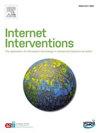再打一个电话就够了吗?-额外人力支持对减少基于互联网的抑郁症状干预的辍学率的有效性:一项随机对照试验
IF 3.6
2区 医学
Q1 HEALTH CARE SCIENCES & SERVICES
Internet Interventions-The Application of Information Technology in Mental and Behavioural Health
Pub Date : 2025-03-11
DOI:10.1016/j.invent.2025.100818
引用次数: 0
摘要
基于互联网的干预措施(IBIs)是精神障碍的有效治疗方法,但其实施面临挑战,特别是在解决高辍学率方面。增加更多的人工支持或指导可能会降低ibi的治疗辍学率,但也可能限制可扩展性。因此,有必要采用小型、易于实施、基于指南的附加干预措施来降低辍学率。这项研究测试了提供一个额外的简短电话联系是否会减少IBI治疗抑郁症症状的辍学率。方法我们分析了N = 394名参加IBI的抑郁症患者的数据。干预包括7个基于cbt的模块,每个模块都有来自心理治疗师的书面半标准化反馈(引导IBI)。先前的研究将相同的IBI应用于自我报告有抑郁症状的成年人,发现第二个模块后辍学率增加。在研究组中,治疗师在第二个模块后提供了额外的简短电话(n = 206)。在对照组,不提供额外的电话(n = 188)。我们对两组的干预过程进行描述性统计。我们进行了逻辑回归来检验额外的电话对治疗退出的预防作用。结果研究组和对照组的合并退学率分别为30.5% (n = 63)和36.1% (n = 68),两者风险差约6个百分点。比值比为1.25 ~ 1.33,相对危险度为1.08 ~ 1.10。然而,所有的置信区间重叠为零,表明所有的效应估计在统计上不显著。结论:我们测试了一种增加人际接触的策略,以减少引导性IBI治疗抑郁症状的中途退出率。所有的估计在描述上都偏向于研究组,但都很小且不显著。需要进一步的研究来确定如何利用额外的接触来减少治疗退出。本文章由计算机程序翻译,如有差异,请以英文原文为准。
Is one additional phone call enough? - Effectiveness of additional human support to reduce dropout from an internet-based intervention for depressive symptoms: A randomized-controlled trial
Background
Internet-Based Interventions (IBIs) are effective treatments for mental disorders, but their implementation faces challenges, particularly in addressing high dropout rates. Adding more human support or guidance might reduce treatment dropout rates in IBIs, but it may also limit scalability. Therefore, small, easy-to-implement, guidance-based add-on interventions are warranted to reduce dropout rates. This study tests if offering one additional brief phone contact reduces treatment dropout rates in an IBI for depressive symptoms with written guidance.
Methods
We analyze data from N = 394 individuals participating in an IBI for depression. The intervention comprises seven CBT-based modules with module-wise written semi-standardized feedback from psychotherapists (guided IBI). Previous research applying the same IBI in adults with self-reported symptoms of depression found increased dropout rates after the second module. In the study group, therapists offered an additional brief phone call after the second module (n = 206). In the control group, no additional phone calls were offered (n = 188). We present descriptive statistics regarding the intervention course for both groups. We conducted a logistic regression to examine the preventive effect of the additional phone call on treatment dropout.
Results
Pooled dropout rates in the study group were 30.5 % (n = 63), and in the control group 36.1 % (n = 68), with a risk difference of about 6 % points favoring the study group. The odds ratios ranged from 1.25 to 1.33, and the relative risks ranged from 1.08 to 1.10. However, all confidence intervals overlap zero, indicating that all effect estimates are statistically non-significant.
Conclusion
We tested a strategy of additional human contact to reduce treatment dropout rates in a guided IBI for depressive symptoms. All estimates descriptively favored the study group, but were small and non-significant. Further research is needed to determine how additional contact can be employed to reduce treatment dropout.
求助全文
通过发布文献求助,成功后即可免费获取论文全文。
去求助
来源期刊

Internet Interventions-The Application of Information Technology in Mental and Behavioural Health
Medicine-Health Informatics
CiteScore
6.50
自引率
9.30%
发文量
94
审稿时长
6 weeks
期刊介绍:
Official Journal of the European Society for Research on Internet Interventions (ESRII) and the International Society for Research on Internet Interventions (ISRII).
The aim of Internet Interventions is to publish scientific, peer-reviewed, high-impact research on Internet interventions and related areas.
Internet Interventions welcomes papers on the following subjects:
• Intervention studies targeting the promotion of mental health and featuring the Internet and/or technologies using the Internet as an underlying technology, e.g. computers, smartphone devices, tablets, sensors
• Implementation and dissemination of Internet interventions
• Integration of Internet interventions into existing systems of care
• Descriptions of development and deployment infrastructures
• Internet intervention methodology and theory papers
• Internet-based epidemiology
• Descriptions of new Internet-based technologies and experiments with clinical applications
• Economics of internet interventions (cost-effectiveness)
• Health care policy and Internet interventions
• The role of culture in Internet intervention
• Internet psychometrics
• Ethical issues pertaining to Internet interventions and measurements
• Human-computer interaction and usability research with clinical implications
• Systematic reviews and meta-analysis on Internet interventions
 求助内容:
求助内容: 应助结果提醒方式:
应助结果提醒方式:


